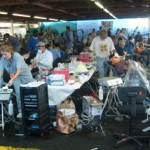With expanding Medicaid about to become a major issue with the incoming Terry McAuliffe administration, it is curious to see exactly where the poor people in Virginia live. An intriguing New York Times interactive graph provides clues and allows one to draw some rather disturbing conclusions.
The single worst pocket of poverty of 76.7% appears to be in an inner city part of Hampton. Trailing not far behind are inner city parts of Norfolk (67.8%) and Portsmouth (64.9%).
Much-touted RVA is a hotbed for low-income people as defined by individuals making less than $11,945 a year or a family of four making $23,283 a year. Despite all the hoopla you read about Richmond becoming an artsy draw for white, educated millennials, the capital, at least its downtown and east end, is as poor as church mice.
An east end section near Fairfield Avenue is 67.% poor. Manchester south of downtown has rates of 35% and farther south it is 50.7%.
Zip over the mostly white Short Pump area where the fancy stores are in Henrico and poverty is about 2 percent. I tried to look up where Jim Bacon lives but the chart said it was a “low population area” and rates weren’t available. My area in southwestern Chesterfield is about 3 percent.
A cursory scan around the state did not show any poverty rates anywhere close to those of the inner cities of Tidewater or Richmond –certainly not in Northern Virginia although Winchester seemed a little sketchy.
In more rural areas, Halifax County in the dying tobacco and textile belt was high but the surrounding area was low. An area near Lynchburg showed 50 percent levels.
Another curiosity was that once you get to the Southwest, you can see the black hand of coal. The Virginia coalfields are generally just west of U.S. 19. Giles County to the east of it has poverty rates of about 13 %. But cross to the western counties and watch it double (Buchanan 23%; Dickenson, 21.3% and Wise, 25.6%).
What do these counties have in common? A dying coal industry and even dying is a misnomer. One would think that these areas would be swimming in money thanks to black diamonds. Anything but. They’ve been stripped and raped with the wealth flowing elsewhere. This is something to keep in mind when you hear about “The War on Coal.” Turns out the “War on People Living Near Coal Mines” has been going on since the late 19th century.
The Times chart is a wonderful reality check. It should have huge applications as expanding Medicaid is considered. The lesson seems to be that extreme poverty is concentrated in neglected inner city neighborhoods and abused rural areas.
If (God forbid!) poor people start flocking to emergency rooms once they get Medicaid, those emergency rooms are likely to be in large, downtown teaching hospitals like the Virginia Commonwealth University Health Systems and Sentara Norfolk General Hospital. They won’t be in rich, white suburban areas for the simple reason that public transit is lacking. In rural areas, the poor may well have to find rides to take them dozens of miles to find care.
(Hat tip to Scott Elmquist)



